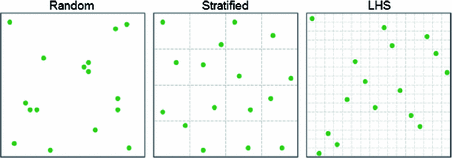

Latin hypercube sampling and infectious diseases code#
The morbidity and mortality caused by infection with a virulent strain of the virus can be as high as 100% and it is listed in the World Organisation for Animal Health (OIE) Terrestrial Animal Health Code and must be reported to the OIE Terrestrial Animal Health Code. Suids are the only susceptible animals to ASFV. ConclusionsĪll the identification of the spatio-temporal patterns of the epidemic and the risk analysis model would give a further understanding of the dynamics of disease transmission and help to design corresponding measures to minimize the catastrophic consequences of potential ASFV introduction.Īfrican swine fever (ASF) is the most serious epidemic disease in the pig industry, which is caused by the African swine fever virus (ASFV). The Latin hypercube sampling results show that the probability is relatively low (the average value is 4.577 × 10 − 7). And then, a quantitative model was constructed to analyse the risk of releasing African swine fever virus (ASFV) from Poland by the legal export of pork and pork products. Through space-time scan statistical analysis, the 3 clusters major of wild boar cases involve longer time spans and larger radii, while the other five with higher relative risks involved in domestic pigs. The results show that the center of the epidemic moved gradually towards the southwest, and the distribution of the epidemic changed from south-north to east-west. In this study, the Geographic Information System (GIS) spatial analysis was applied to analyze the distribution, dispersion of the epidemic and clustering of ASF in Poland. ASF poses a potential threat to the world pig industry, due to the lack of vaccines and treatments. (The three components of Ro are associated with fast, slow, and relapse TB.) fl0 estimates indicated the existence of fairly severe epidemics when TB epidemics first arose.African swine fever (ASF) is a devastating infectious disease of pigs. The uncertainty analysis allowed for the derivation of a frequency distribution for Ro and the assessment of the relative contribution each of the three components of Ro made when TB epidemics first arose centuries ago. On the basis of replicated Latin hypercube sampling, the authors performed an uncertainty and sensitivity analysis of the basic reproductive rate of tuberculosis (YB). The basic reproductive rate (R ^ is a measure of the severity of an epidemic.

Our analysis demonstrates that it is possible to improve our understanding of the behavior of tuberculosis epidemics by applying time-dependent uncertainty and sensitivity analysis to a transmission model.] The time-dependent sensitivity analysis revealed that only a few of the model's input parameters significantly affected the severity of a tuberculosis epidemic these parameters were the disease reactivation rate, the fraction of infected individuals who develop tuberculosis soon after infection, the number of individuals that an infectious individual infects per year, the disease death rate, and the population recruitment rate. Calculated values (from the uncertainty analysis) for the disease incidence, disease prevalence, and mortality rates were approximately consistent with historical data. The time-dependent uncertainty analysis enabled us to evaluate the variability in the epidemiological outcome variables of the model during the progression of a tuberculosis epidemic. Previously we have formulated transmission models of untreated tuberculosis epidemics (Blower et al., Nature, Medicine 1 (1995), 815 821) in this paper, we present time-dependent uncertainty and sensitivity analyses in order to quantitatively understand the transmission dynamics of tuberculosis epidemics in the absence of treatment.


 0 kommentar(er)
0 kommentar(er)
